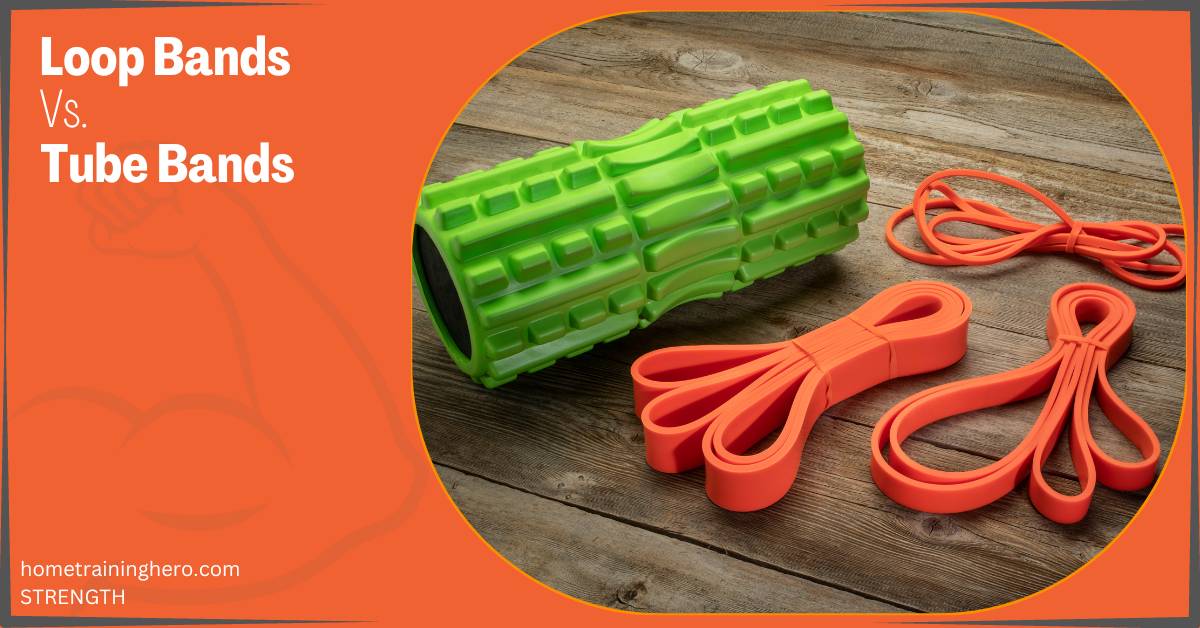In recent years, resistance bands have become increasingly popular in the fitness world – offering a convenient and versatile way to amp up your workouts.
With so many options available, it’s important to understand the differences between various types of resistance bands to ensure you’re making the right choice for your fitness goals. In this article, we’ll delve into the debate of loop bands vs tube bands, exploring the strengths and weaknesses of each option and helping you determine which one is better suited for your workout routine.
Now, let’s get to it!
Contents
The Basics of Resistance Bands
Before we dive into the specifics of loop bands and tube bands, let’s quickly revisit the basics of resistance bands. These bands are flexible elastic bands made from durable materials such as rubber or latex, designed to provide varying levels of resistance when stretched. They come in different colors, each denoting a different level of resistance. Resistance bands are widely used in strength training, physical therapy, and general fitness routines due to their portability, affordability, and ability to target multiple muscle groups.
Loop Bands: Versatility at Its Best
Loop bands, as the name suggests, form a closed loop with no handles or attachments. These bands are often referred to as mini bands, hip bands, or booty bands. One of the key advantages of loop bands is their versatility. They can be used for a wide range of exercises, including squats, lunges, glute bridges, lateral walks, and even upper body workouts. Loop bands also allow for greater freedom of movement, as they do not restrict your range of motion like some other resistance band types.
The Benefits of Loop Bands
1. Target Multiple Muscle Groups: Loop bands engage multiple muscle groups simultaneously, making them highly effective for full-body workouts. Whether you want to tone your legs, strengthen your core, or sculpt your upper body, loop bands can target various muscle groups with just one piece of equipment.
2. Progressive Resistance: Loop bands offer progressive resistance, meaning the level of difficulty increases as the band is stretched further. This allows for gradual progression in your workouts, accommodating both beginners and advanced fitness enthusiasts.
3. Convenient for Travel: The compact size and lightweight nature of loop bands make them an ideal travel companion. You can easily pack them in your suitcase or gym bag, ensuring you never miss a workout while on the go.
4. Injury Prevention and Rehabilitation: Loop bands are often recommended for injury prevention and rehabilitation purposes. They provide gentle resistance, allowing you to strengthen weak muscles and improve stability without putting excessive strain on your joints.
The Drawbacks of Loop Bands
While loop bands offer numerous benefits, it’s important to consider their limitations as well:
1. Limited Heavy Resistance: Loop bands typically provide lighter resistance compared to tube bands. If you’re looking to build significant muscle mass or require higher levels of resistance, loop bands might not be the most suitable option.
2. Less Versatile for Certain Upper Body Exercises: Although loop bands can be used for upper body workouts, they may not be as versatile as tube bands for exercises that require a firm grip or specific hand positioning. For example, exercises like bicep curls or tricep extensions may be better performed with tube bands.
3. Difficulty in Changing Resistance: Unlike tube bands that offer interchangeable levels of resistance through attachments or handles, loop bands have a fixed resistance level. To increase or decrease the resistance, you need to switch to a different band with a higher or lower intensity.
Tube Bands: Power and Flexibility
Tube bands, also known as resistance tube bands or exercise bands with handles, consist of a rubber or latex tube with handles at each end. These handles provide a firm grip and allow for easy attachment to various anchor points, such as door frames or workout benches. Tube bands offer a different set of advantages compared to loop bands.
The Benefits of Tube Bands
1. Wide Range of Resistance Levels: Tube bands often come with interchangeable attachments or handles that allow you to adjust the level of resistance. This makes them suitable for both beginners and advanced users, as you can easily switch between different resistance levels.
2. Greater Resistance Options: If you’re looking for heavy resistance to build muscle mass and strength, tube bands are a better choice than loop bands. The ability to attach multiple bands to a single handle provides increased resistance options, making tube bands more versatile in terms of intensity.
3. Enhanced Grip and Stability: The handles of tube bands offer a secure grip, providing stability during exercises that require a strong handhold. This makes them particularly advantageous for upper body workouts, such as rows, presses, and curls.
4. Specific Upper Body Exercises: Tube bands excel in exercises that require specific hand positioning or variations. For example, you can easily perform tricep kickbacks, lateral raises, or chest presses with tube bands, utilizing their handles to maintain proper form and target specific muscle groups.
The Drawbacks of Tube Bands
Despite their numerous benefits, tube bands also have some limitations:
1. Limited Range of Motion: Tube bands may restrict your range of motion, especially in exercises that require long stretches or extensive movement. The presence of handles can potentially limit your flexibility, impacting the effectiveness of certain exercises.
2. Less Portable: Compared to loop bands, tube bands are slightly less portable due to their larger size and handles. While they can still be packed for traveling, they may take up more space in your bag compared to compact loop bands.
3. Single Plane Resistance: Tube bands primarily provide resistance in a single plane, typically following the line of the band. This limitation may not allow for broader multidirectional movements that some workouts demand.
Loop Bands vs Tube Bands: Which One is Better?
The question of whether loop bands or tube bands are better ultimately depends on your specific fitness goals, preferences, and workout routine. To help you make an informed decision, here are some factors to consider:
1. Exercise Variety: If you aim to incorporate a wide range of exercises into your routine, including lower-body, core, and upper-body workouts, loop bands offer greater versatility. However, if you have a particular focus on upper body exercises or want to perform exercises with specific hand positions, tube bands might be a better fit.
2. Resistance Levels: If you require heavy resistance for building muscle mass or strength, tube bands provide a wider range of options. On the other hand, if you prefer lighter resistance or are focused on toning, loop bands can fulfill your needs effectively.
3. Portability: If you travel frequently or prefer working out in different locations, the compact size and lightweight nature of loop bands make them a convenient choice. However, if portability isn’t a major concern, tube bands can still be easily transported and offer additional resistance options.
4. Budget: In terms of affordability, loop bands tend to be more cost-effective compared to tube bands. If you’re on a tight budget or just starting your fitness journey, purchasing a set of loop bands can provide a solid foundation for your resistance training.
5. Comfort and Handling: Consider how comfortable each type of band feels during your workouts. Some individuals may find the grip and stability provided by tube bands more favorable, while others may prefer the freedom of movement offered by loop bands.
Final Words
Both loop bands and tube bands have their unique advantages and limitations. The best choice for your workout routine depends on your fitness goals, preferences, and exercises you plan to incorporate.
Loop bands excel in versatility and full-body workouts, whereas tube bands offer a wider range of resistance options and enhanced grip for specific upper-body exercises. Ultimately, experimenting with both types of resistance bands can help you determine which one suits your needs and helps you achieve your desired fitness results.
Remember, regardless of the type of bands you choose, consistency and proper form are key to reaching your fitness goals effectively.
Other Helpful Resources
- Why Resistance Bands are Better Than Weights: 5 Reasons to Add Resistance Bands to Your Workout Routine
- When to Use Resistance Bands in Your Workouts
- What Type of Resistance Bands Should I Buy? The Ultimate Guide to Choosing the Right Resistance Bands
- 7 Super Effective Ab Exercises With a Resistance Band
- Are Resistance Bands Good for Building Muscle? Science And Facts




